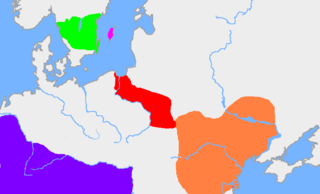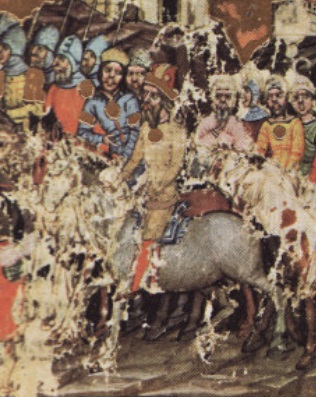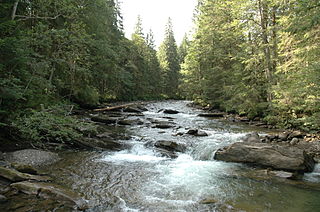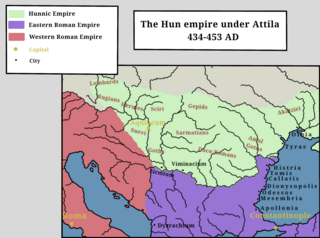
The Ostrogoths were a Roman-era Germanic people. In the 5th century, they followed the Visigoths in creating one of the two great Gothic kingdoms within the Western Roman Empire, drawing upon the large Gothic populations who had settled in the Balkans in the 4th century. While the Visigoths had formed under the leadership of Alaric I, the new Ostrogothic political entity which came to rule Italy was formed in the Balkans under Theodoric the Great.

Ermanaric was a Greuthungian Gothic king who before the Hunnic invasion evidently ruled a sizable portion of Oium, the part of Scythia inhabited by the Goths at the time. He is mentioned in two Roman sources: the contemporary writings of Ammianus Marcellinus, and in Getica by the sixth-century historian Jordanes. He also appears in a fictionalized form in later Germanic heroic legends.

The Sciri, or Scirians, were a Germanic people. They are believed to have spoken an East Germanic language. Their name probably means "the pure ones".

Oium was a name for Scythia, or a fertile part of it, roughly in modern Ukraine, where the Goths, under a legendary King Filimer, settled after leaving Gothiscandza, according to the Getica by Jordanes, written around 551.
The Amali – also called Amals, Amalings or Amalungs – were a leading dynasty of the Goths, a Germanic people who confronted the Roman Empire during the decline of the Western Roman Empire. They eventually became the royal house of the Ostrogoths and founded the Ostrogothic Kingdom.
Farnobius was a Gothic chief who was killed in a battle with the Roman army of Frigeridus while trying to cross the mountains from Thrace into Illyricum.

The Sack of Rome on 24 August 410 AD was undertaken by the Visigoths led by their king, Alaric. At that time, Rome was no longer the administrative capital of the Western Roman Empire, having been replaced in that position first by Mediolanum in 286 and then by Ravenna in 402. Nevertheless, the city of Rome retained a paramount position as "the eternal city" and a spiritual center of the Empire. This was the first time in almost 800 years that Rome had fallen to a foreign enemy, and the sack was a major shock to contemporaries, friends and foes of the Empire alike.

Trajan's Wall is the name used for several linear earthen fortifications (valla) found across Eastern Europe, Moldova, Romania, and Ukraine. Contrary to the name and popular belief, the ramparts were not built by Romans during Trajan's reign, but during other imperial periods. Furthermore, the association with the Roman Emperor may be a recent scholarly invention, only entering the imagination of the locals with the national awakening of the 19th century. Medieval Moldavian documents referred to the earthworks as Troian, likely in reference to a mythological hero in the Romanian and Slavic folklore. The other major earthen fortification in Romania, Brazda lui Novac, is also named after a mythological hero.

Between 376 and 382 the Goths fought against the Eastern Roman Empire, one of several Gothic Wars in Roman history. This conflict included a catastrophic Roman defeat at the Battle of Adrianople, and is commonly seen as a part— albeit a part of disputed significance— of the century of events leading to the Fall of the Western Roman Empire.
The Early Middle Ages in Romania started with the withdrawal of the Roman troops and administration from Dacia province in the 270s. In the next millennium a series of peoples, most of whom only controlled two or three of the nearly ten historical regions that now form Romania, arrived. During this period, society and culture underwent fundamental changes. Town life came to an end in Dacia with the Roman withdrawal, and in Scythia Minor – the other Roman province in the territory of present-day Romania – 400 years later. Fine vessels made on fast potter's wheels disappeared and hand-made pottery became dominant from the 450s. Burial rites changed more than once from cremation to inhumation and vice versa until inhumation became dominant by the end of the 10th century.
The Thervingi, Tervingi, or Teruingi were a Gothic people of the plains north of the Lower Danube and west of the Dniester River in the 3rd and the 4th centuries.

The Greuthungi were a Gothic people who lived on the Pontic steppe between the Dniester and Don rivers in what is now Ukraine, in the 3rd and the 4th centuries. They had close contacts with the Tervingi, another Gothic people, who lived west of the Dniester River. To the east of the Greuthungi, living near the Don river, were the Alans.

The Taifals or Tayfals were a people group of Germanic or Sarmatian origin, first documented north of the lower Danube in the mid third century AD. They experienced an unsettled and fragmented history, for the most part in association with various Gothic peoples, and alternately fighting against or for the Romans. In the late fourth century some Taifali were settled within the Roman Empire, notably in western Gaul in the modern province of Poitou. They subsequently supplied mounted units to the Roman army and continued to be a significant source of cavalry for early Merovingian armies. By the sixth century their region of western Gaul had acquired a distinct identity as Thifalia.
Michael Kulikowski is an American historian. He is a professor of history and classics and the head of the history department at Pennsylvania State University. Kulikowski specializes in the history of the western Mediterranean world of late antiquity. He is sometimes associated with the Toronto School of History and was a student of Walter Goffart.

Athanaric's Wall, also called Lower Trajan's Wall or Southern Trajan's Wall, was a fortification line probably erected by Athanaric, between the banks of river Gerasius and the Danube to the land of Taifali. Most probably, Athanaric's Wall has reused the old Roman limes called Limes Transalutanus.

Balamber was ostensibly a chieftain of the Huns, mentioned by Jordanes in his Getica. Jordanes simply called him "king of the Huns" and writes the story of Balamber crushing the tribes of the Ostrogoths in the 370s; somewhere between 370 and more probably 376 AD.

The Prut is a river in Eastern Europe. It is a left tributary of the Danube, and is 953 km (592 mi) long. Part of its course forms Romania's border with Moldova and Ukraine.
Vithimiris was a king of the Greuthungi, ruling for some unspecified time in the area of present-day southern Ukraine. He succeeded to Ermanaric, meaning that he probably reigned in 376. Ammianus Marcellinus, the only known source on him, states that after Ermanaric's death he tried to resist the Alani, who were allied with the Huns, with the help of other Huns hired as mercenaries. He did so "for some time", but eventually, "after many defeats", he died in battle. It is then assumed that he most probably ruled in 376, possibly also in 375.

The history of the Huns spans the time from before their first secure recorded appearance in Europe around 370 AD to after the disintegration of their empire around 469. The Huns likely entered Western Asia shortly before 370, from Central Asia: they first conquered the Goths and the Alans, pushing a number of tribes to seek refuge within the Roman Empire. In the following years, the Huns conquered most of the Germanic and Scythian tribes outside of the borders of the Roman Empire. They also launched invasions of both the Asian provinces of Rome and the Sasanian Empire in 375. Under Uldin, the first Hunnic ruler named in contemporary sources, the Huns launched a first unsuccessful large-scale raid into the Eastern Roman Empire in Europe in 408. From the 420s, the Huns were led by the brothers Octar and Ruga, who both cooperated with and threatened the Romans. Upon Ruga's death in 435, his nephews Bleda and Attila became the new rulers of the Huns, and launched a successful raid into the Eastern Roman Empire before making peace and securing an annual tribute and trading raids under the Treaty of Margus. Attila appears to have killed his brother, and became sole ruler of the Huns in 445. He would go on to rule for the next eight years, launching a devastating raid on the Eastern Roman Empire in 447, followed by an invasion of Gaul in 451. Attila is traditionally held to have been defeated in Gaul at the Battle of the Catalaunian Fields, however some scholars hold the battle to have been a draw or Hunnic victory. The following year, the Huns invaded Italy and encountered no serious resistance before turning back.
Frigeridus was a Roman general of Germanic descent. Under Valentinian I he was the military commander (dux) of Pannonia. Following the Battle of Marcianople, he was directed by Gratian, Valentian's successor, to lead forces from Pannonia to Thrace to deal with the invading Goths. He did not command his own forces in the Battle of Ad Salices, ostensibly due to an attack of gout.













